Nag Panchami, a vibrant Hindu festival, holds a unique place in the Sawan month, a period of lush greenery and spiritual significance. Celebrated with immense devotion, this auspicious day is dedicated to the reverence of snakes, known as Nagas, who are considered divine beings in Hinduism.
If you’re looking to understand the profound traditions and spiritual essence of this ancient observance, here’s your complete guide to Nag Panchami 2025, covering its exact date, sacred timings, and deep significance.
Nag Panchami 2025: Date & Auspicious Timings
Mark your calendars! Nag Panchami in 2025 will be observed on Tuesday, July 29th. This festival always falls on the fifth day (Panchami Tithi) of the bright fortnight (Shukla Paksha) during the holy month of Shravan (Sawan) in the Hindu lunar calendar.
- Festival Date: Tuesday, July 29, 2025
- Panchami Tithi Begins: 7:54 PM on Monday, July 28, 2025
- Panchami Tithi Ends: 9:16 PM on Tuesday, July 29, 2025
- Puja Muhurat (Auspicious Time for Worship): 05:41 AM to 08:23 AM on July 29, 2025
- The Pooja Muhurat will last for a duration of 2 hours and 43 minutes.
This special day falls on the fifth day (Panchami) of the bright fortnight (Shukla Paksha) of the Shravan month, a time when the natural world flourishes under monsoon rains.
Spiritual Significance of Nag Panchami
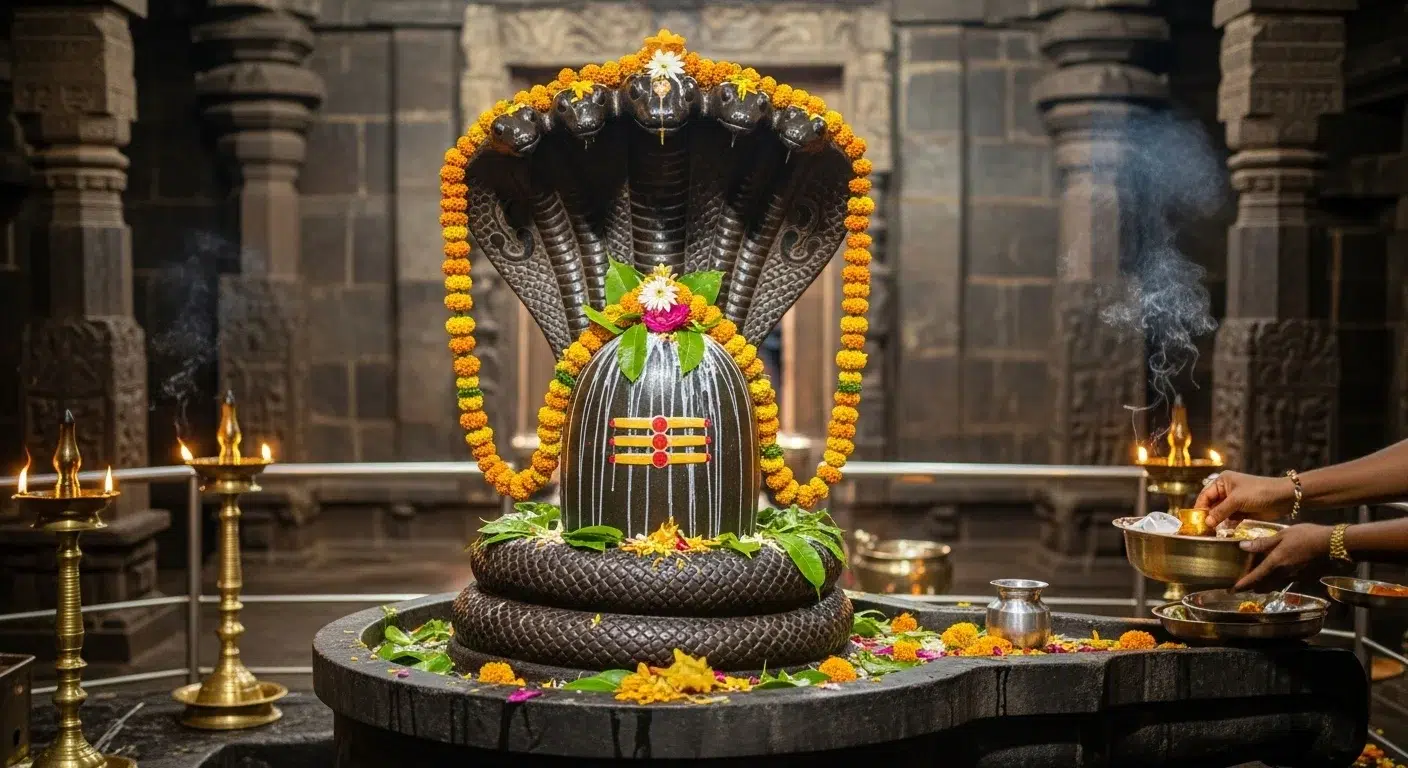
Nag Panchami is on the fifth day (Panchami) of the Shukla Paksha of Shravan (Sawan) month, a most auspicious period in Hindu culture. Serpent worship is an ancient tradition associated with fertility, protection, and divine patronage.
Snakes are divine symbols tied to key gods:
- Lord Shiva has Vasuki around his neck.
- Lord Vishnu sleeps on the thousand-headed Sheshnag.
- Lord Subramanya is also worshipped as a serpent.
Why Do We Honor Serpents? The Sacred Significance of Nag Panchami
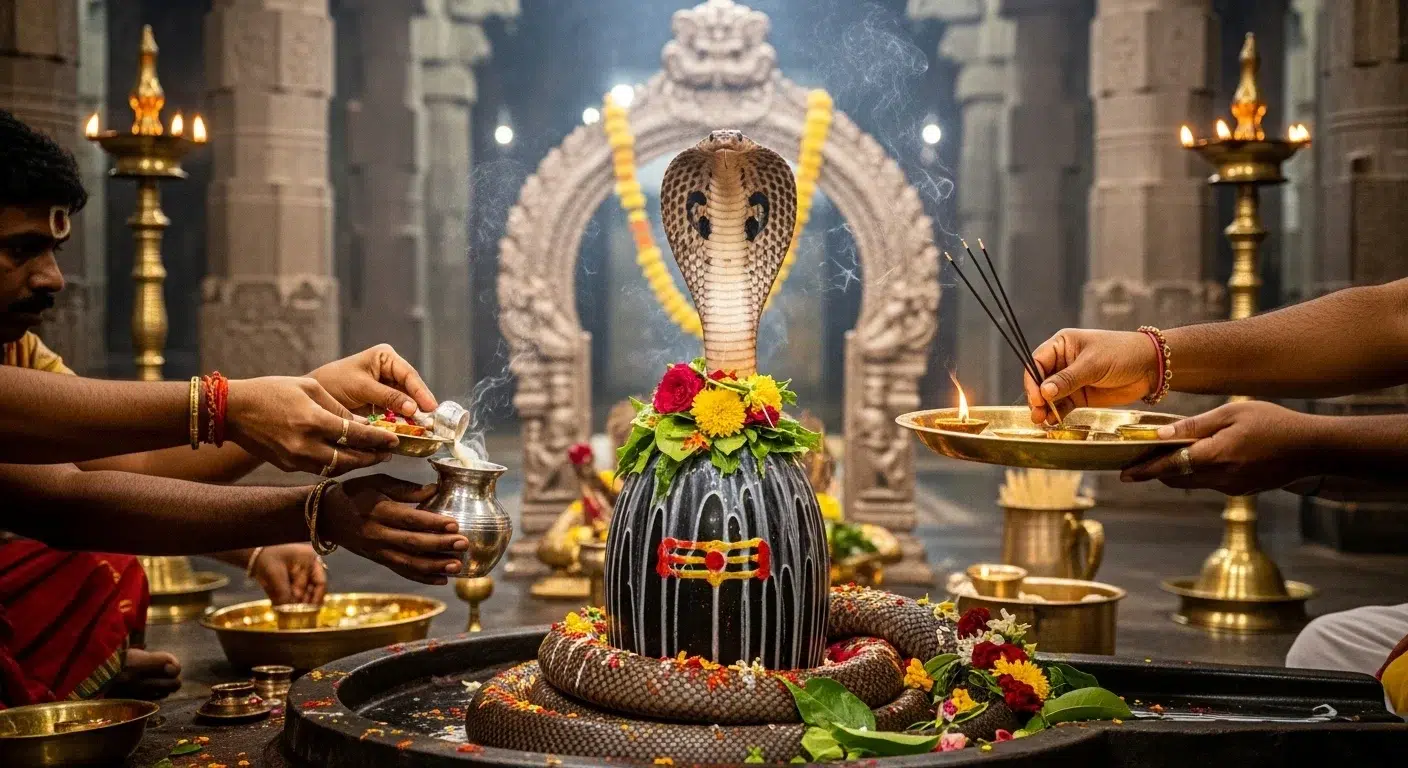
In Hindu mythology and culture, Nagas (serpents) are not merely creatures; they are powerful deities deeply intertwined with the cosmic balance and spiritual realms. Nag Panchami is a special occasion to honor these mystical beings and recognize their vital role.
- Divine Worship: The day is specifically designated for serpent worship, where devotees offer prayers to actual snakes or their idols.
- Blessings and Safeguarding: Observing this ritual is believed to invoke the protection of Nag deities, safeguarding homes and families from snake bites and bringing prosperity.
- Harmony with Nature: Nag Panchami highlights Hinduism’s profound reverence for nature and its diverse creations, promoting ecological awareness and respect for all living beings.
- Symbolic Power: Serpents symbolize various profound concepts in Hinduism, including creation, destruction, fertility, rebirth, and the cosmic energy that sustains the universe.
- Community Connection: The festival often fosters community engagement through traditional fairs and collective devotional practices, strengthening social bonds.
- Associated Deities: Nagas have strong connections with major Hindu gods. They are depicted as resting places for Lord Vishnu (on Ananta Shesha) and as adornments for Lord Shiva (around his neck).
Must Read: Explore 10 Most Popular Shiva Temples in North India
The Ancient Roots: History Behind Nag Panchami
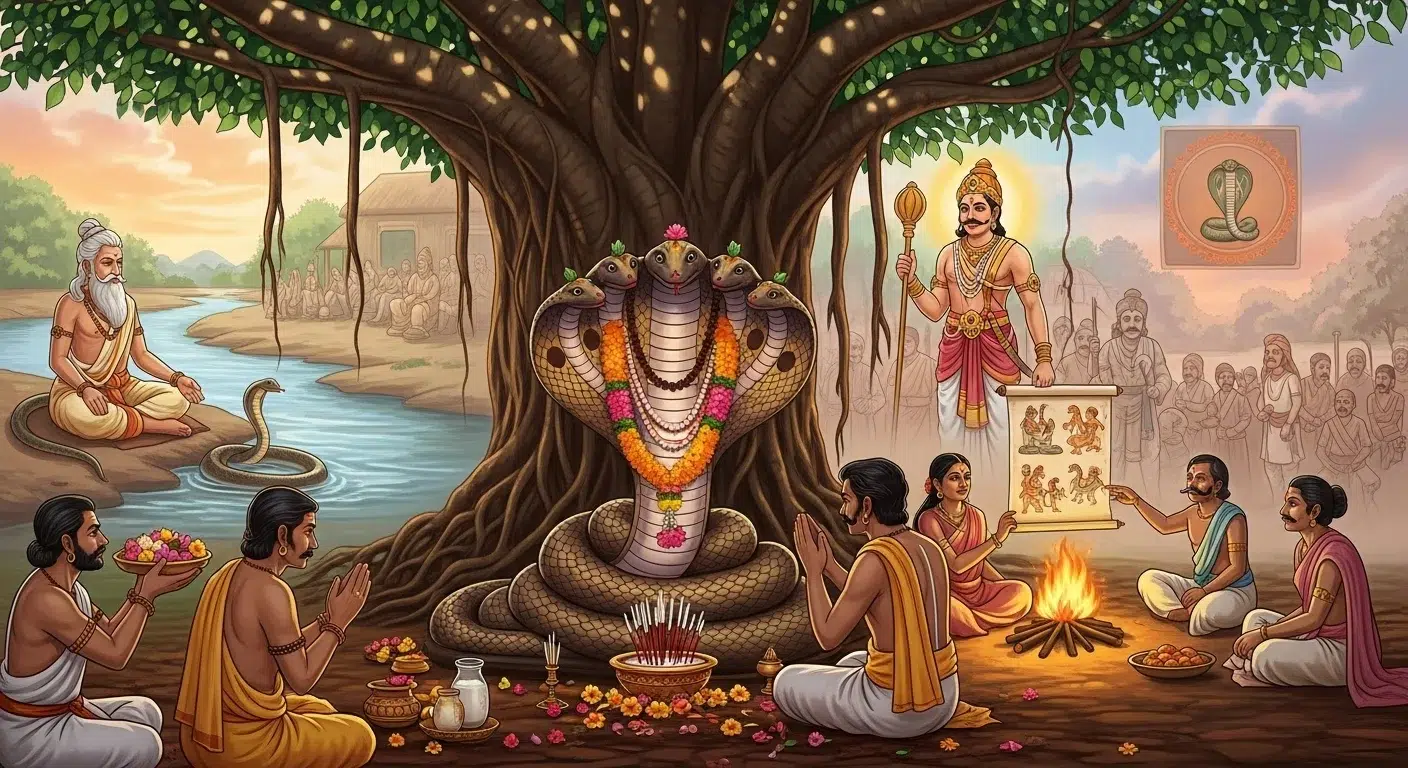
The spiritual significance of Nag Panchami is rooted in several ancient mythological tales found in revered Hindu scriptures like the Mahabharata, Narada Purana, and Skanda Purana.
The most prominent legend revolves around King Janamejaya of the Kuru dynasty.
- King Janamejaya’s Sacrifice: The most prominent legend involves King Janamejaya, the son of Arjuna’s grandson Parikshit. After Parikshit died from a snake bite by Nagraj Takshaka, King Janamejaya performed a mighty Sarpa Yaga (snake sacrifice) to avenge his father’s death and eradicate all snakes from the Earth.
- The Power of Mantras: During the Yaga, powerful Vedic mantras chanted by Brahmin sages began pulling countless snakes into the sacrificial fire.
- The End of the Yaga: Astika Muni, with his profound knowledge and wisdom, impressed King Janamejaya and persuaded him to halt the Sarpa Yaga on the fifth day of the Shravan month.
- The Ritual’s Intensity: As the elaborate ritual commenced, the powerful mantras chanted by Brahmin sages began to draw countless snakes into the sacrificial fire. Even Takshaka, who sought refuge with Indra, the king of deities, found himself being pulled towards the yagna.
- Intervention and Forgiveness: Witnessing the devastating plight of the serpent race, the celestial gods appealed to Goddess Manasa, the revered queen of snakes, for intervention. She sent her wise son, Astika, to King Janamejaya. Young Astika’s earnest pleas and profound knowledge convinced the king to halt the destructive ritual and forgive Takshaka.
- Origin of the Festival: Since that fateful fifth day of the Shravan month, the practice of worshipping Nagas and refraining from harming them has been observed as Nag Panchami, a day dedicated to their protection and preservation. This historical narrative underscores the festival’s deep roots in ancestral reverence and cosmic balance.
Nag Panchami Puja Vidhi: Simple Rituals for Home Worship
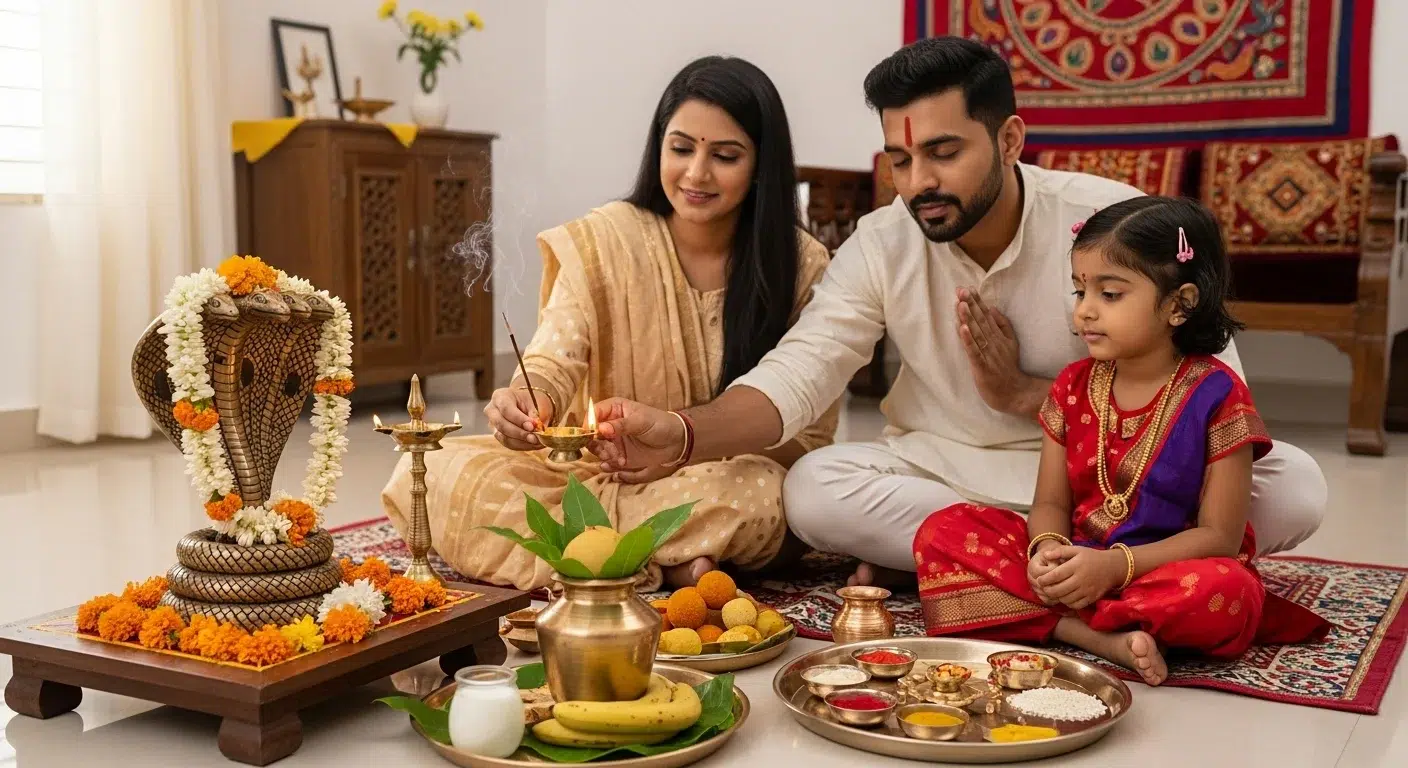
Observing Nag Panchami puja at home involves specific rituals to seek divine blessings and protection from serpent deities.
- Morning Preparations: Begin your day by waking up early and purifying yourself with a holy bath. Traditionally, a rangoli depicting snake figures is drawn near the puja area or entrance using auspicious materials like sandalwood paste, turmeric, or flowers.
- Holy Offerings: During the sacred Muhurat, devotees typically offer milk, ghee, honey, and rice (or kheer) at snake pits, ant hills, or at temples dedicated to Nagas.
- Pooja Items: Arrange your पूजा सामग्री (puja items) including fresh flowers, incense sticks, a diya (lamp), sweets, fruits, and water.
- Idol Worship at Home: For snake worship at home, you can use brass, silver, or clay idols of Nagas. Place them reverently in your puja space.
- Chanting Mantras: Enhance your devotion by chanting powerful Nag Panchami Stotrams and the Nag Gayatri Mantra throughout the worship.
- Observing a Fast: Many devotees choose to observe a fast (Vrat) on Nag Panchami. This can range from a partial fast (consuming fruits and milk) to a strict Nirjala Vrat (without water), symbolizing their sincere dedication and devotion.
Nag Panchami Celebrations Across India: Regional Traditions
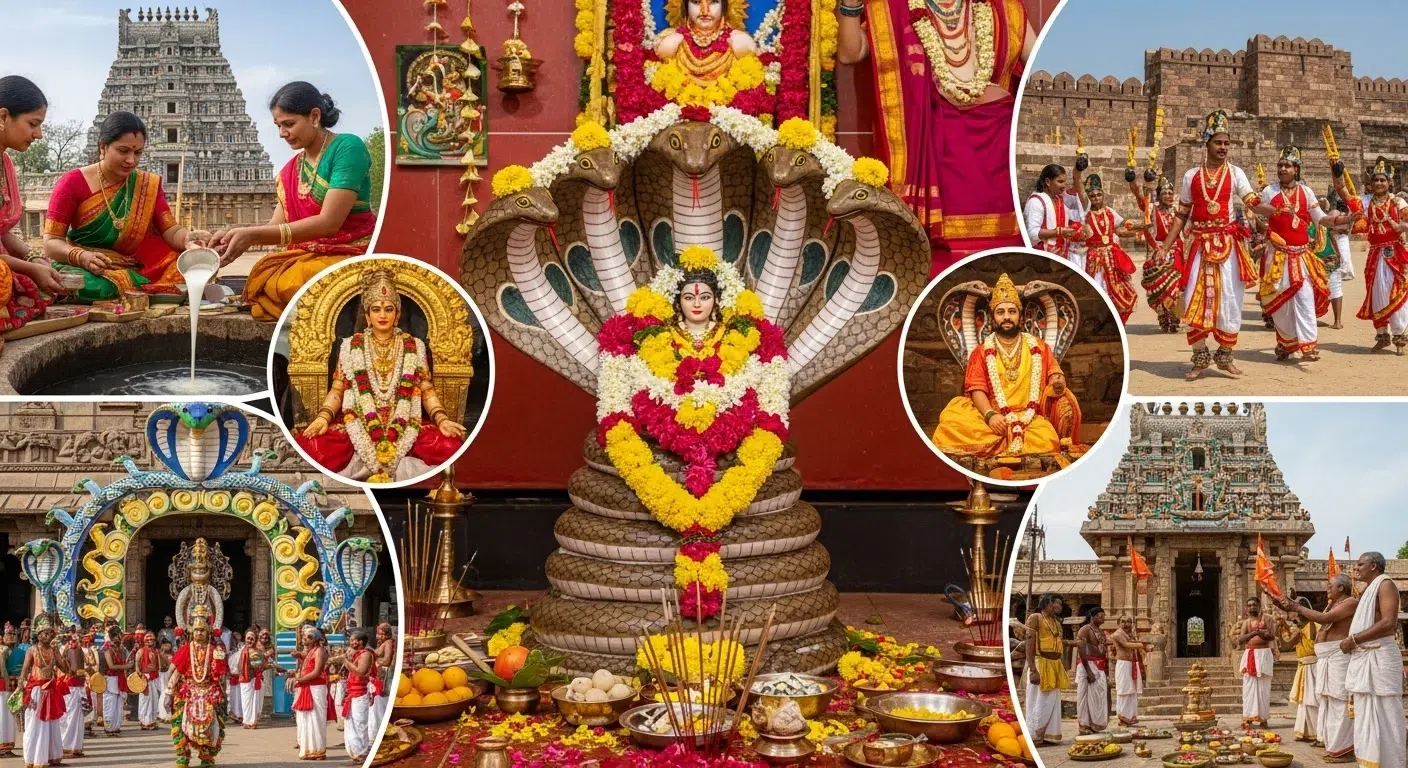
The observance of Nag Panchami, while universally significant, showcases diverse traditional practices across India. Each region adds its unique cultural flavor to this ancient festival.
- Maharashtra & Karnataka: In these western and southern states, women devoutly offer milk and light diyas (oil lamps) at active snake pits or dedicated Nag temples, seeking blessings for their families.
- Southern States (Tamil Nadu & Kerala): Known as Aadi Panchami, the festival here involves special temple visits for naga abhisheka (sacred bathing of serpent idols) and offering milk to serpent shrines.
- Assam & West Bengal: In the eastern regions, the day is celebrated as Mansa Puja, with devotees fervently worshipping Mansa Devi, who is revered as the goddess of serpents and fertility.
- Bihar & Uttar Pradesh: In these northern states, devotees often offer milk, honey, and ghee near snake pits in their fields. A key tradition here is for farmers to refrain from ploughing or disturbing the earth, out of respect and to protect snakes.
Must Visit: Nag Panchami 2025: Famous Snake Temples in India You Can Visit for Blessings
Conclusion
Nag Panchami is more than just a festival; it’s a deep-rooted cultural and spiritual practice that underscores humanity’s ancient connection with nature and the divine. It celebrates the reverence for serpents, symbolizing fertility, cosmic balance, and the vanquishing of negative energies. Across India, the day is marked by sincere ritual, holy offerings, and temple visits, all culminating in prayers for protection and prosperity. This ancient Hindu festival serves as a powerful reminder of respect for all forms of life and the intricate balance of our ecosystem.
Must Read: A Divine Journey to the 12 Jyotirlingas of India
Frequently Asked Questions
Q1: When is Nag Panchami Celebrated in 2025?
Ans: Nag Panchami in 2025 will be observed on Tuesday, July 29th.
Q2: What are the key puja timings for Nag Panchami 2025?
Ans: The main Puja Muhurat on July 29, 2025, is from 05:41 AM to 08:23 AM.
Q3: What is the spiritual significance of Nag Panchami?
Ans: It’s a day to honor Nagas (serpent deities) for their protective powers, seek blessings, and express reverence for nature and cosmic balance.
Q4: Why do devotees celebrate Nag Panchami?
Ans: The festival commemorates the legend of Astika Muni, who prevented King Janamejaya’s snake sacrifice, thus symbolizing the protection and preservation of serpents.
Q5: What are the typical rituals for Nag Panchami worship?
Ans: Common rituals include taking a holy bath, drawing Nagas, offering milk, ghee, and other items to snake idols or pits, chanting mantras, and often observing a fast.
Q6: What is the legend behind Nag Panchami?
Ans: The festival’s origin is linked to the Mahabharata, specifically Astika Muni’s intervention to stop King Janamejaya’s snake sacrifice, thus saving the serpent race.
Q7: What are the common rituals observed on Nag Panchami?
Ans: Devotees typically offer milk, ghee, and honey to snake idols or at temples. Many also observe a fast, apply vermilion, and chant sacred mantras for blessings.
Q8: Why do people worship snakes (Nagas) on this day?
Ans: Hindus worship Nagas as divine deities, seeking their blessings for protection, prosperity, and acknowledging their symbolic role in nature and cosmic balance.







